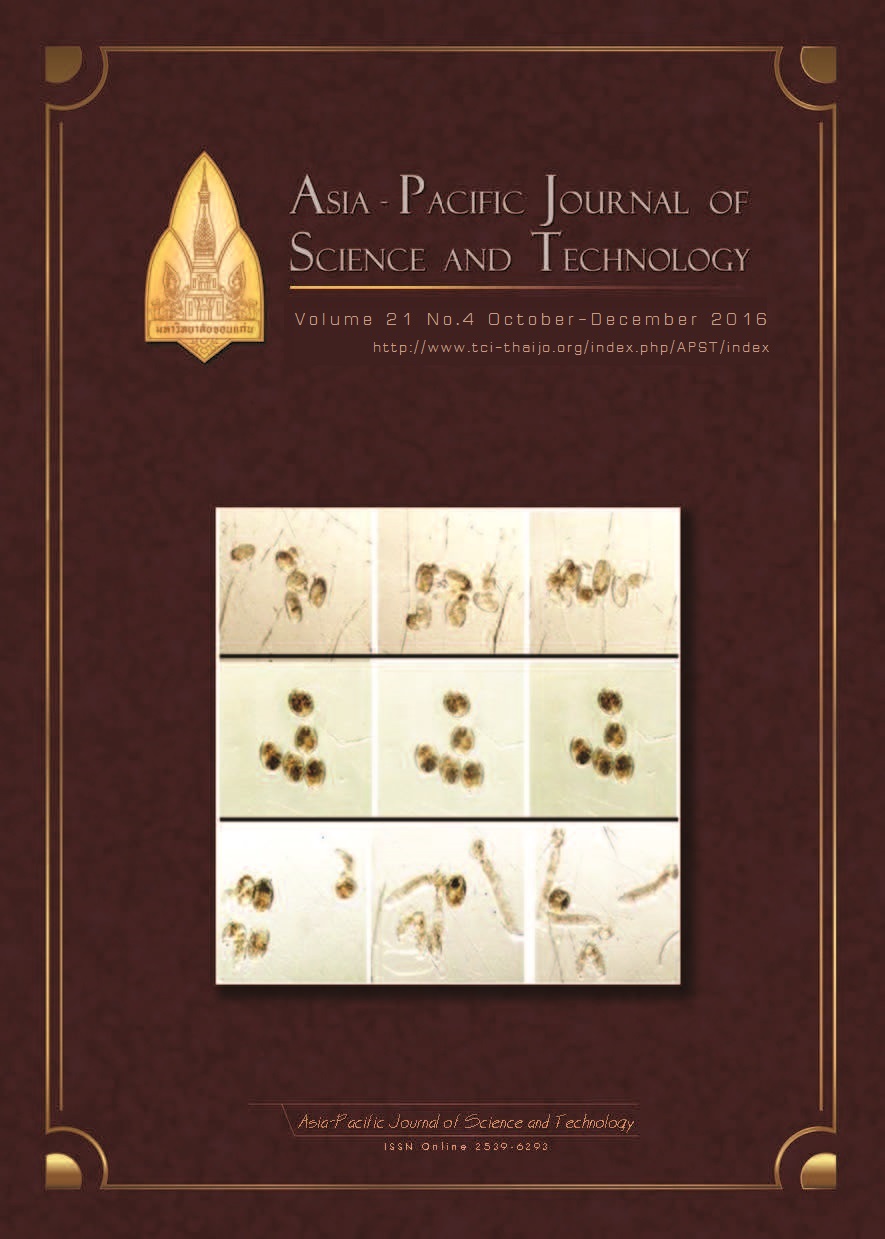Carbon stock assessment under different ages of rubber tree plantation
Main Article Content
Abstract
Rubber tree is an important economic crop which has created economic value of Thailand. Soil acts as one of important component of the global carbon cycle as they store large amounts of organic carbon. In addition, soil organic carbon and soil organic matter are crucial component for soil quality and productivity assessment. However, they probably sensitive to plant age, ecosystem management and climate change. The objective of this study was to investigate the effect of different rubber tree plantation ages, including 1) 3 years rubber tree plantation (3Y), 2) 11 years rubber tree plantation (11Y), 3) 17 years rubber tree plantation (17Y) and 4) 27 years rubber tree plantation (27Y) on carbon stock. The result suggested that different age of rubber tree plantation has an effect on carbon stock. The highest soil carbon stock was found in 17Y, but showed no significant different when compared to 27Y. The greatest above ground biomass was observed in 27Y. Interestingly, younger age of rubber tree showed that soil carbon stock was sequestered in the form of microbial biomass carbon, due to lowest qCO2 was determined.
Article Details
References
[2] Saengruksawong, C., Khamyong, S., Anongrak, N., Pinthong, J., 2012. Growths and carbon stocks of para rubber plantations on phonpisai soil series in northeastern Thailand. Rubber Thai Journal 1,1-18.
[3] Bremner, J.M., 1960. Determination of nitrogen in soil by the Kjeldahl method. Journal of Agricultural Science 55, 11-33.
[4] Bray, R.H., Kurtz, L.T., 1945. Determination of total, organic, and available forms of phosphorus in soils. Soil science 59, 39-45.
[5] Walkley, A., Black, I.A., 1934. An examination of the Degtjareff method for determining soil organic matter, and a proposed modification of the chromic acid titration method. Soil science 37, 29-38.
[6] Amato, M., Ladd, J.N., 1988. Assay for microbial biomass based on ninhydrin reactive nitrogen in extracts of fumigated soil. Soil Biology and Biochemistry 20, 107–114. [7] Sparling, G.P., West, A.W., 1988. A direct extraction method to estimate soil microbial C: calibration in situ using microbial respiration and 14C labeled cells. Soil Biology and Biochemistry 20, 337-343.
[8] Anderson, J.P.E., 1982. Agronomy monograph number 9, part II. In: Page AL, Miller RH, Keeney DR, editors. Chemical and biological properties. Madison: American Society of Agronomy and Soil Science Society of America, 831–871.
[9] Franchini, J.C., Crispino, C.C., Souza, R.A., Torres, E., Hungria, M., 2007. Microbiological parameters as indicators of soil quality under various tillage and crop-rotation systems in southern Brazil. Soil and Tillage Research 92, 18–29.
[10] Milne, E., 2012. Soil organic carbon [WWW Document]. URL http://www.eoearth.org/article/soil_organic_carbon (accessed 12. 11 15).
[11] Kraenzel, M., Castillo, A., Moore, T., Potvin, C., 2003. Carbon storage of harvest-age teak (Tectona grandis) plantations, Panama. Forest Ecology and Management 173, 213–225.
[12] Murbach, M.R., Boaretto, A.E., Muraoka, T., de Souza, E.C.A., 2003. Nutrient cycling in a RRIM 600 clone rubber plantation. Scientia Agricola 60, 353-357.
[13] Santos, D.C.F., Grazziotti, P.H., Silva, A.C., Trindade, A.V., Silva, E.D.B., Costa, L.S.D., Costa, H.A.O., 2011. Microbial and soil properties in restoration areas in the Jequitinhonha valley, Minas Gerais. Revista Brasileira de Ciência do Solo 35, 2199-2206 refers to Gama-rodrigues, E.F., Barros, N.F., Gama-rodrigues, A.C., Santos, G.A., 2005. Nitrogênio, carbono e atividade da biomassa microbiana do solo em plantações de eucalipto. Revista Brasileira de Ciência do Solo 29, 893-901.
[14] Puttaso, P., Pnomkhum, P., Rungthong, R., Promkhambut, A., Kaewjampa, N., Lawongsa, P., 2015. Microbial biomass and activity under different ages of rubber tree plantations in northeast Thailand. Khon Kaen Agriculture Journal 43, Suppl 1: S963-967.
[15] Promruksa, W., Smakgahn, K., 2014. Carbon stock in soil rubber plantation. Journal of applied phytotechnology in environmental sanitation 3, 101-107.
[16] Zhang, M., Fu, X., Feng, W., Zou, X., 2007. Soil organic carbon in pure rubber and tea-rubber plantations in South-western China. Tropical ecology 48, 201-207.


